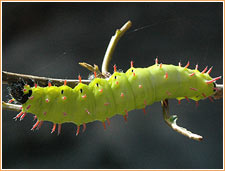| Home > Last Stand: Hope for the Remaining Forests
 |
 |
 |
| A caterpillar in Ranomafana National Park. The park is home to nearly 100 species of butterflies.
|
|
During the last decade this formerly insular, one-party state has witnessed many remarkable changes. It became a democracy in the early '90s. The president, Marc Ravolamanana, has embraced conservation: in 2003, he set a five-year goal to triple the amount of forest area under state protection.
But in a poor country dependent on agriculture, promises can only go so far.
To feed themselves, many farmers resort to hacking subsistence plots out of old-growth forests. Given their dire economic situation, conservation strategies must allow farmers to earn a livelihood.
In this section, you will learn about strategies intended to do just that.
Dan Grossman interviews two American agriculturalists who are
are working with farmers to come up with more forest-friendly practices.
Among the approaches discussed: growing fruit and nut trees as an alternative to environmentally destructive cash crops; using vetervier, a tall grass, for erosion control and increasing productivity of rice paddies.
You'll learn how villages near Ranomafana National Park are
beginning to discover the economic benefits of preserving
the local forest. And you will see photographs of some of Ranomafana's wildlife -- including the aptly named girafe-necked
weevil. You will also hear from researchers cataloguing the area's treasure trove of fauna and flora. And you'll see satellite images of the island and learn what they tell researchers who are evaluating Madagascar's conservation efforts.
Finally, you'll learn from one healthcare educator about the relationship between family planning and conservation.
Learn about the forests and what is being done to protect them by clicking on the links below.
|

